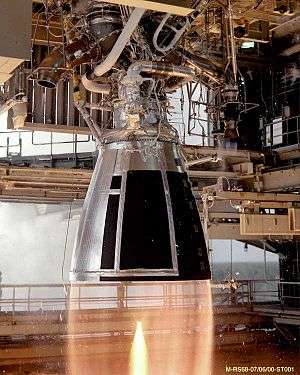Vinci (rocket engine)
Vinci is a European Space Agency cryogenic liquid rocket engine currently under development. It is designed to power the new upper stage of Ariane 6.
.jpg) | |
| Country of origin | |
|---|---|
| Designer | ArianeGroup |
| Manufacturer | ArianeGroup |
| Application | Upper stage liquid rocket booster |
| Predecessor | HM-7B |
| Status | Under Development |
| Liquid-fuel engine | |
| Propellant | LOX / LH2 |
| Mixture ratio | 5.8 |
| Cycle | Expander cycle |
| Configuration | |
| Chamber | 1 |
| Nozzle ratio | 240 |
| Performance | |
| Thrust (vac.) | 180 kN (40,470 lbf) |
| Chamber pressure | 6.08 MPa (60.8 bar) |
| Isp (vac.) | 465 s (4.56 km/s) |
| Dimensions | |
| Length | 4,2 m |
| Diameter | 2.15 m |
| Dry weight | approx. 550 kg without nozzle: 160 kg |
Overview
Vinci is an expander cycle rocket engine fed with liquid hydrogen and liquid oxygen. Its biggest improvement from its predecessor, the HM7B (which powers the ESC-A), is the capability of restarting up to five times. It is also the first European expander cycle engine, removing the need for a gas generator to drive the fuel and oxidizer pumps. The engine features a carbon ceramic extendable nozzle in order to have a large, 2.15 m diameter nozzle extension with minimum length: the retracted nozzle part is deployed only after the upper stage separates from the rest of the rocket; after extension, the engine's overall length increases from 2.3 m to 4.2 m.
Development
Although the ESC-B development was put on hold in 2003, the Vinci project has not been cancelled: at a lower pace, the engine is still being developed. On 22 December 2006, Snecma announced a new ESA contract for Vinci rocket engine long-duration and re-ignition testing.
In late April 2010 the German Aerospace Center DLR announced the start of a six-month test campaign for the Vinci engine at its Lampoldshausen facility.[1] The first successful test firing of this campaign took place on 27 May 2010.[2] A video of a test was released in 2016.[3]
In 2014, NASA was interested with the idea of using the Vinci instead of the RL10 for an upper stage of Space Launch System. The Vinci offers the same specific impulse at the same mass but with 64% greater thrust, which would allow for a reduction of one or two of the four second stage engines for the same performance, while the cost would be lower.[4][5]
As of 2017, the first flight of the Ariane 6 rocket with Vinci is planned for 2020.[6]
In July 2017, Ariane Group reported that the first flight models of the combustion chamber had entered production.[7]
References and notes
- "Vinci – tests on the high-thrust, cryogenic, restartable upper stage engine for Ariane 5 gather pace". Lampoldshausen: German Aerospace Center. 28 April 2010. Retrieved 29 January 2017.
- "First test of Vinci M3 engine a success!" (Press release). Evry: Safran Aircraft Engines. 4 October 2010. Retrieved 29 January 2017.
- "Ariane 6 Vinci engine is tested". 2016-05-17. Retrieved 2017-03-13.
- Todd, David (3 June 2013). "SLS design may ditch J-2X upper stage engine for four RL-10 engines". Seradata Space Intelligence. Archived from the original on 27 December 2016. Retrieved 29 January 2017.
- Todd, David (7 November 2014). "Next Steps for SLS: Europe's Vinci is a contender for Exploration Upper-Stage Engine". Seradata Space Intelligence. Archived from the original on 27 December 2016. Retrieved 29 January 2017.
- "Ariane 6". ESA. January 23, 2017. Archived from the original on 2017-02-14. Retrieved 2017-02-14.
- "ArianeGroup starts production of the first flight model for the VINCI engine combustion chamber intended for the Ariane 6 upper stage". Retrieved 28 July 2017.
- "Launch Vehicle Propulsion – Vinci". EADS SPACE Transportation. Retrieved 2014-08-10.
- "VINCI Thrust Chamber Cryogenic Upper Stage" (PDF). EADS SPACE Transportation. Archived from the original (PDF) on 2006-10-28. Retrieved 2006-11-24.
- Decourt, Rémy (2005-05-24). "Ariane 5: EADS veut geler le développement de la version 12 tonnes" (in French). Futura-Sciences.com. Retrieved 2014-08-10.
- "Snecma announces new ESA contract for Vinci rocket engine". www.safran-group.com. 2006-12-22. Retrieved 2014-08-10.

.jpg)